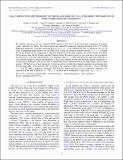X-RAY REFLECTION SPECTROSCOPY OF THE BLACK HOLE GX 339–4: EXPLORING THE HARD STATE WITH UNPRECEDENTED SENSITIVITY
Author(s)
Steiner, James F.; McClintock, Jeffrey E.; Grinberg, Victoria; Dauser, Thomas; Garcia, Javier A.; Remillard, Ronald A; ... Show more Show less
DownloadGarcia-2015-X-RAY REFLECTION SPE.pdf (2.648Mb)
PUBLISHER_POLICY
Publisher Policy
Article is made available in accordance with the publisher's policy and may be subject to US copyright law. Please refer to the publisher's site for terms of use.
Terms of use
Metadata
Show full item recordAbstract
We analyze simultaneously six composite RXTE spectra of GX 339–4 in the hard state comprising 77 million counts collected over 196 ks. The source spectra are ordered by luminosity and span the range 1.6%–17% of the Eddington luminosity. Crucially, using our new tool pcacorr, we re-calibrate the data to a precision of 0.1%, an order of magnitude improvement over all earlier work. Using our advanced reflection model relxill, we target the strong features in the component of emission reflected from the disk, namely, the relativistically broadened Fe K emission line, the Fe K edge, and the Compton hump. We report results for two joint fits to the six spectra: For the first fit, we fix the spin parameter to its maximal value (a* = 0.998) and allow the inner disk radius R[subscript in] to vary. Results include (i) precise measurements of R[subscript in], with evidence that the disk becomes slightly truncated at a few percent of Eddington and (ii) an order-of-magnitude swing with luminosity in the high energy cutoff, which reaches >890 keV at our lowest luminosity. For the second fit, we make the standard assumption in estimating spin that the inner edge of the accretion disk is located at the innermost stable circular orbit (R[subscript in] = R[subscript ISCO]) and find a* = 0.95[+0.03 over -0.05] (90% confidence, statistical). For both fits, and at the same level of statistical confidence, we estimate that the disk inclination is i = 48° ± 1° and that the Fe abundance is super-solar, A[subscript Fe] = 5 ± 1.
Date issued
2015-10Department
MIT Kavli Institute for Astrophysics and Space ResearchJournal
The Astrophysical Journal
Publisher
IOP Publishing
Citation
Garcia, Javier A., James F. Steiner, Jeffrey E. McClintock, Ronald A. Remillard, Victoria Grinberg, and Thomas Dauser. “X-RAY REFLECTION SPECTROSCOPY OF THE BLACK HOLE GX 339–4: EXPLORING THE HARD STATE WITH UNPRECEDENTED SENSITIVITY.” The Astrophysical Journal 813, no. 2 (October 29, 2015): 84. © 2015 The American Astronomical Society
Version: Final published version
ISSN
1538-4357
0004-637X